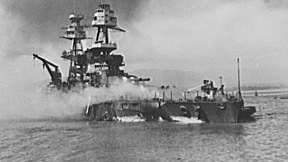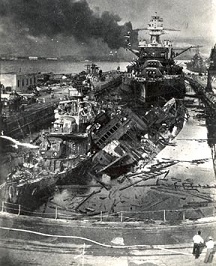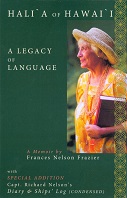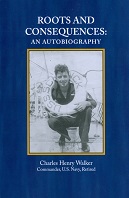 |
The damaged and beached USS Nevada, for which the USS Medusa provided supplies. U.S. Navy photo. |
|
William Roy Dillow Sr. - family of William Watson Dillow of Bloomington, IL -
a career Navy officer, rising from electrician to lieutenant commander, and a veteran of both World War I and World War II. Joined the Navy circa 1913 and, for the first eight years until 1921, served aboard nine vessels, among them the USS Glacier, USS Chattanooga, USS Pueblo and USS Lawrence. Among his posts was in 1918 in Cristobal in the Panama Canal Zone. During his career he also served on submarines, battleships and auxiliary vessels. He is said to have been aboard the USS Medusa in Pearl Harbor during the attack. The Medusa, the Navy's first repair ship built for the purpose of major repairs, fired on a Japanese midget submarine and shot down two dive bombers during the Dec. 7 action. In the aftermath, the Medusa provided rescue services for the men trapped in the capsized Utah, machine gun ammunition to the damaged and beached battleship Nevada and rifles to troops at Schofield Barracks.
 |
| Harold Fawcett's famous photograph |
Harold S. "Jabo" Fawcett - family of Robert Patterson and Minnie Clyde (Johnson) Fawcett of Grafton, WV - a Navy photographer stationed at Pearl Harbor in late 1941. Photographed the wreckage of the U.S.S. Pennsylvania and destroyers Downes and Cassin, in the aftermath of the battle. The New York Times reported that he "captured memorable scenes of the Japanese attack ... Some of [his] photographs of mighty American warships exploding, burning and rolling belly up were considered too disturbing to be made public soon after the outbreak of World War II. These images began to be published on the first anniversary of the attack in Life magazine and in many American newspapers." The Pennsylvania image has been reproduced in many books, including Collier's Photographic History of World War II. |
 |
| Frances Frazier's book |
Harold “Hal” Frazier - family of Charles Taylor and Cordelia (Menefee) Frazier of Tunnelton, WV – employed at Hawaiian Dredging Company at the time, making improvements to the harbor as war loomed. The morning of the attack, despite the Sunday off day, he went to work at the West Loch facility, where the Navy stored large quantities of fuel and ammunition. Back home, his wife Frances Nelson Frazier was preparing breakfast. Their hillside residence provided “a perfect view over Ford Island and Battleship Row,” she wrote in her memoir, Hali'a of Hawai'i: A Legacy of Language. She heard explosions and could see plumes of smoke and the enemy airplanes flying low in the sky. Fearful that she would never see Harold again, and concerned for the life of her baby, she “bundled him in a warm blanket” and placed him in a wooden packing crate near their home. As she looked out over the scene, she could see that one ship had already overturned and then, with rage and horror, saw the Arizona explode. She and neighbors observed the rest of the action, heard flying shrapnel buzzing in the air and learned later that a bullet had hit a neighbor’s house. Harold himself was several miles away from Battleship Row and was unharmed. When he returned home later that day the couple dug a small trench under their house as a foxhole.
 |
| Charles Walker's book |
Charles Henry Walker - family of Cyrus and Elizabeth (Miner) Lindley of Washington County, PA – was aboard the USS Arctic in Maui on Dec. 6-Dec. 7, in preparation for a voyage to San Francisco. The Arctic, a fully armed refrigerator cargo vessel, was in Maui to be de-magnetized to prevent the hull from attracting underwater mines. As the ship’s radioman, Charles received an urgent message about the attack. General quarters was sounded, with all available men ordered to battle stations and all guns immediately loaded. Unidentified aircraft could be seen in the distance. In his memoir Roots and Consequences: An Autobiography, Charles writes about the decisions facing the ship’s captain – whether to head out to sea and risk detection – or remain in port – while the Arctic maintained radio silence. The captain’s final decision was to say put, with guns ready, in the event further action was needed. Later that day, Charles intercepted a coded message instructing the ship to proceed to the mainland as originally planned.
Earl Judd Walls - husband of Phyllis Pearl Rollf of the family of Harvey S. and Frances Ellen "Ella" (Ferguson) Bristol of Buchanan, MI and stepson of Earl Miller. Was stationed in Pearl Harbor as a yeoman in the supply division of a submarine base and survived the attack. He soonafter sent a card home to reassure his parents that he was "safe," reported the Niles Daily Star. |
